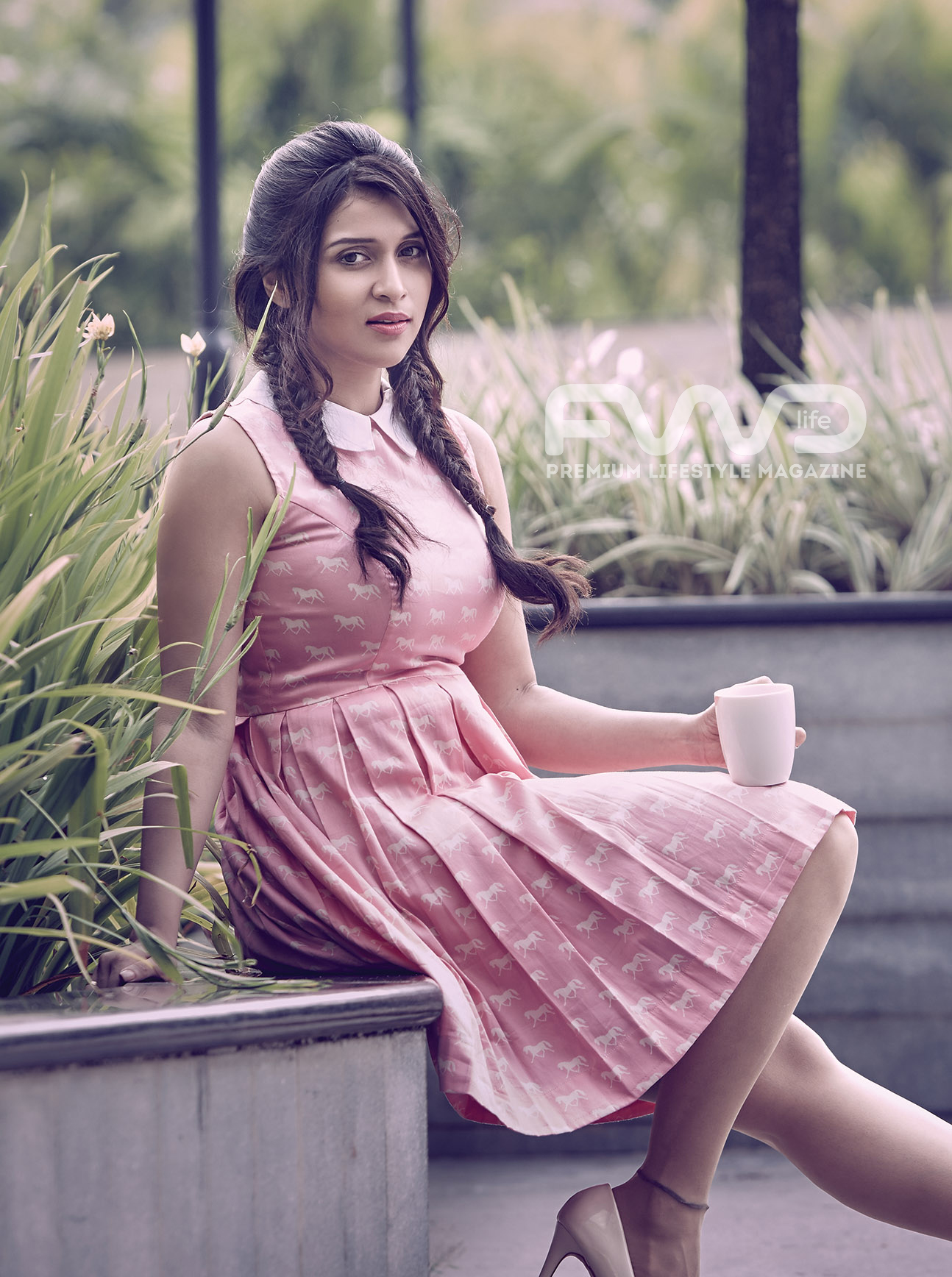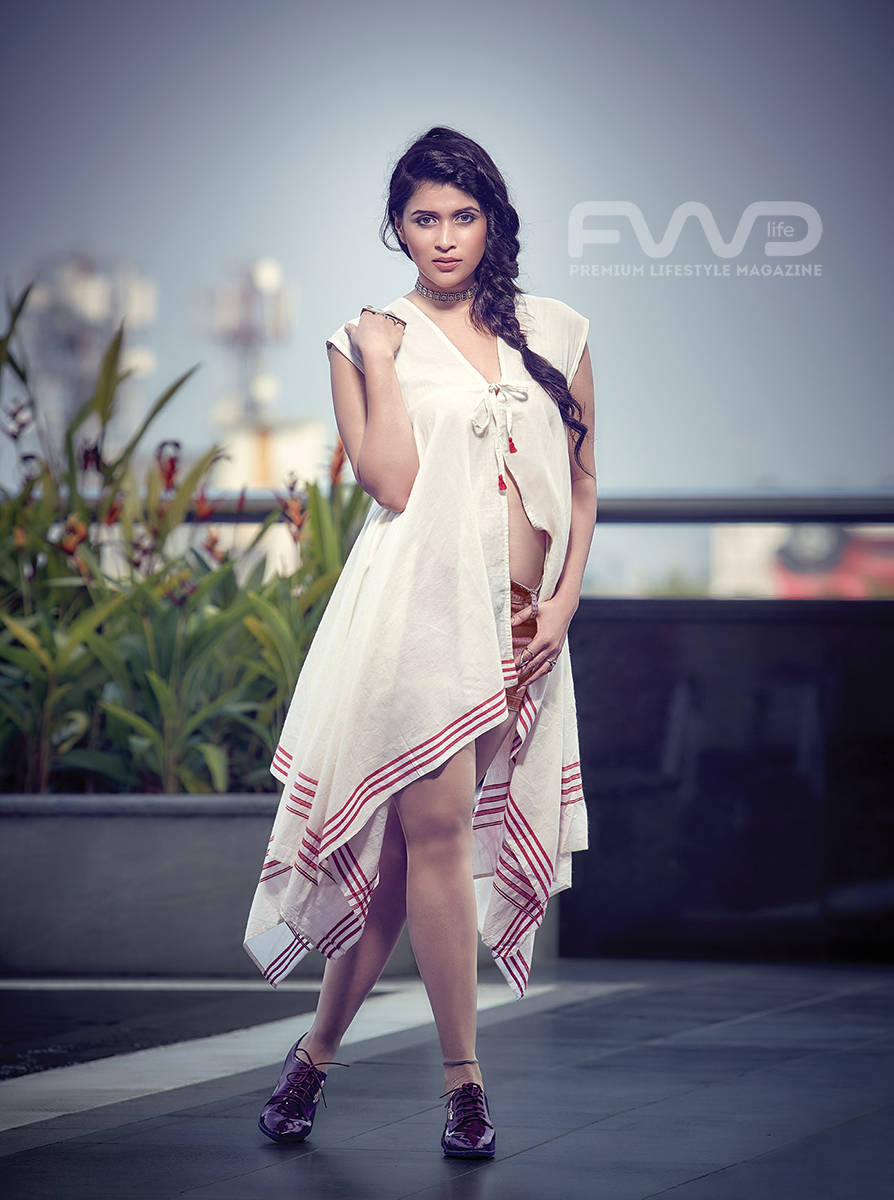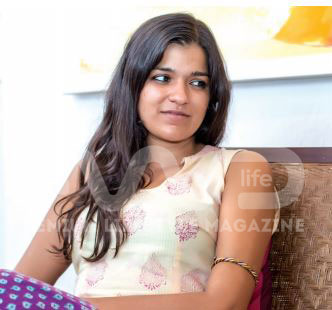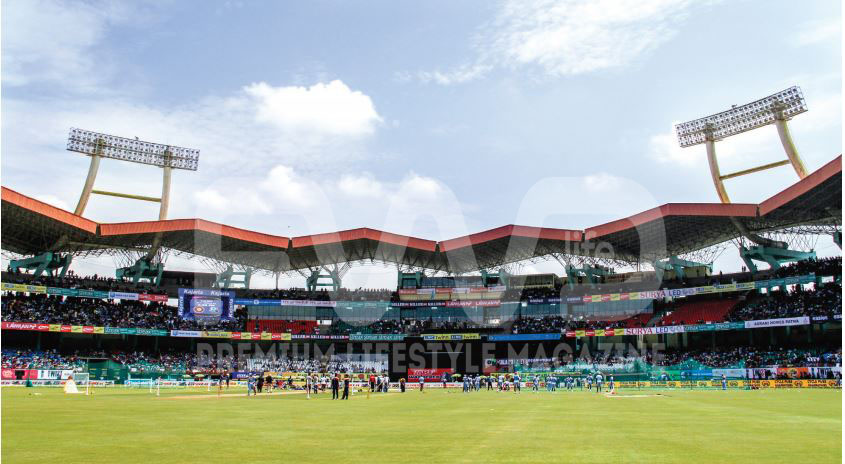The post All You Need To Know About Reenu Mathews appeared first on FWD Life | The Premium Lifestyle Magazine |.
]]>Text: Maria John Photos: FWD Media
A Quick Word with Reenu Mathews
Your onscreen character that you identified with the most
Annie in Immanuel. She may not have dressed like me, but felt very close to me.
Some characters are so much older than you actually are. How old do you feel?
Oh, 18!
If you were cast in Boeing Boeing, which character would you play?
Probably Elena. Lisie’s character that falls in love with Mohanlal.
What do you love about Kerala?
Food again (laughs). The greenery and monsoons. I wish people here would take better care of their surroundings.
Who would you want to be stuck in a lift with and what would you do?
Amir Khan or Mr.Bachchan! Talk about movies and passion.
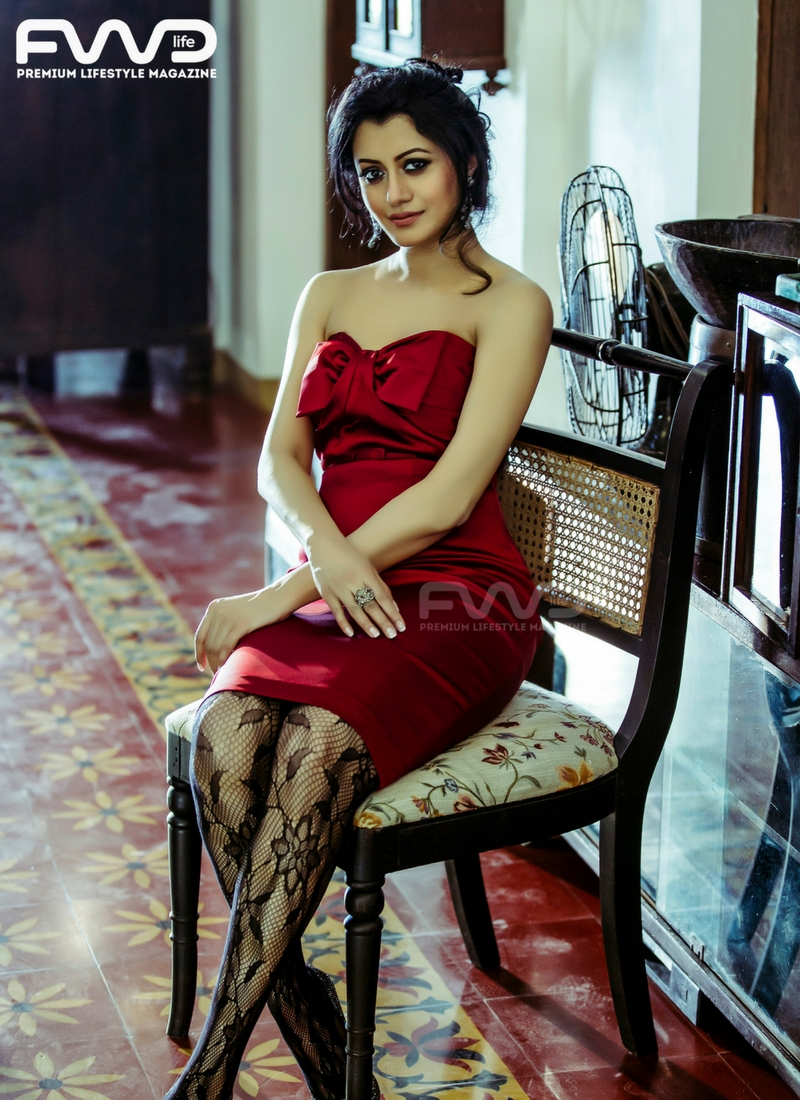
If someone wanted to impress you and take you on a date?
I don’t like showoffs. Simplicity matters to me. When guys remember something you told them before and they do small gestures with that in mind, it means a lot. But the shortcut is food (laughs).
Next desired destination
Georgia or Cyprus. I would like to go to Santorini with someone special.
A song you identify with
When You Say Nothing At All by Ronan Keating.
How do you define style?
Anything that makes you comfortable.
What do you love about Dubai?
Food, shopping, meeting different people. I feel safe in Dubai
So how does Reenu Mathews relax!
By eating. I love food. People sometimes don’t believe it. I love trying different cuisines but of course I am particular to naadan food. Then I do things like everybody else, listen to music, go for movies, window shop or even catch a spa break.
There is not much about you on the internet and you seem like a private person.
Maybe because I am not in Kerala unless mostly there is a shoot. Also my friends circle is very small.
Are you an expert on jetlag?
I am not an expert on jet lag, but I have come a long way. It was difficult to adjust to different time zones. You learn from every crew you fly with.
There is not much about you online. I did a google search and it suggested things like Reenu Mathews hot kissing scene, navel…
It’s weird isn’t it? It is not even my pictures and I keep thinking when did I do such things?
The post All You Need To Know About Reenu Mathews appeared first on FWD Life | The Premium Lifestyle Magazine |.
]]>The post ELEGANCE IN LINE appeared first on FWD Life | The Premium Lifestyle Magazine |.
]]>Her lucent silhouette against the bright sunlight amidst curtains dancing to a subtle breeze would remind you of fairies from a Disney movie. Mannara is sister number three from the celebrated Chopra family to dazzle Bollywood, after her predecessors Priyanka and Parineeti. She is a model, fashion designer and now waiting to unveil her prowess as an actress. If you happen to wonder what made us decide to feature this gorgeous woman from Delhi as our cover model for this Travel and Food special issue, the reason will amuse you. At birth, Mannara was named Barbie Handa. But her cousin suggested ‘Mannara’ as a nickname, inspired by a particular three-course meal special at the Shiv Sagar Restaurant in Mumbai. Mannara’s mother liked it so much that the name became official. Such is the effect food has on some people! Mannara Chopra, on her way to great heights in the world of cineblitz, is a simple woman with the grace of a child. FWD brings you more on her journeys and flavours.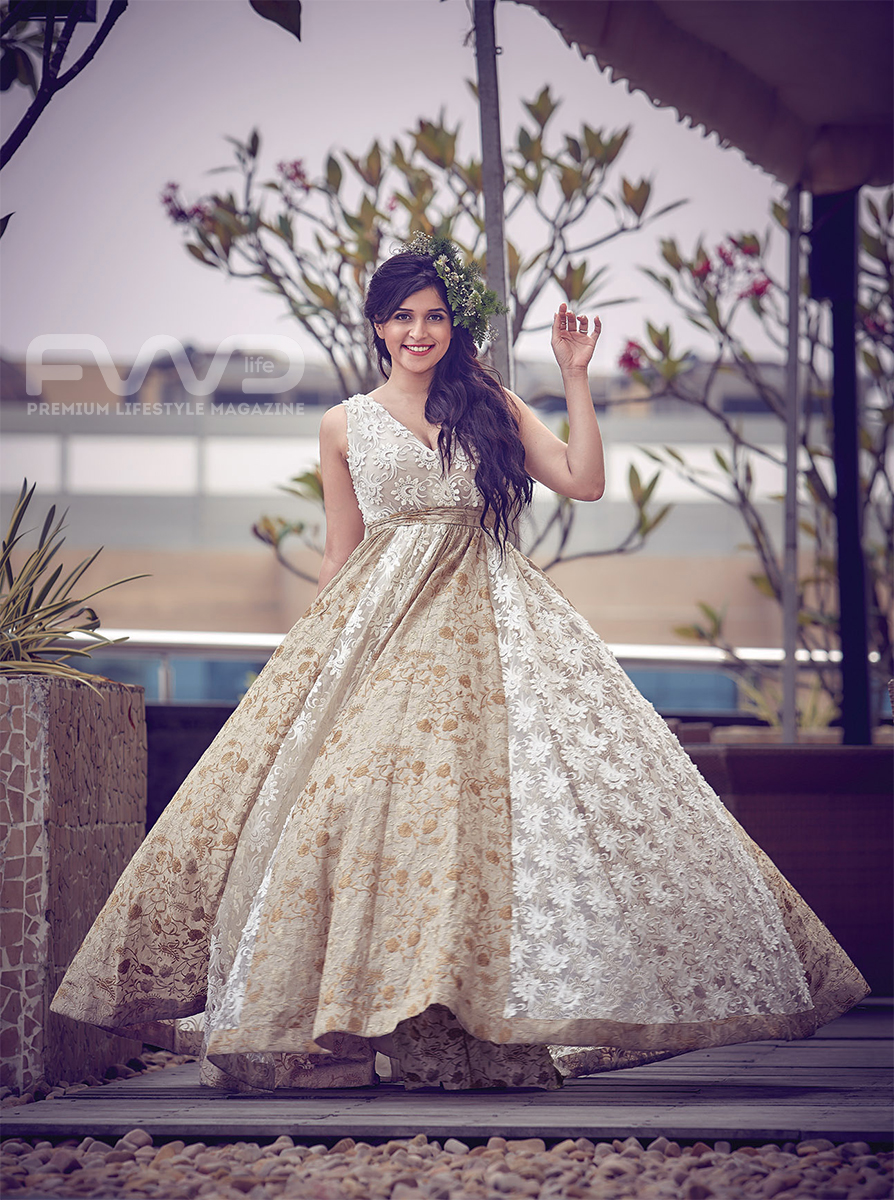
Of Many Expressions
Mannara pursued a BBA degree, before she stepped into the magical world of movies. “Watching Priyanka grow big in the industry has been an inspiration for me,” she said. Mannara moved from Delhi to Mumbai, to begin her career in the modelling industry. She made 13 commercials, and incidentally in three of them, she shared screen space with Priyanka Chopra. This is when she started getting noticed in the South Indian film industry.
Shortly thereafter, she signed her first Telugu movie ‘Prema Geema Jantha Nai’ that released in 2014. “Meeting different people from different places, the lifestyle and characters you meet, all of that is a great experience. I feel it has helped me evolve as a person and as an actor,” she said. Next came her Bollywood debut, Anubhav Sinha’s ‘Zid’, which won her much recognition from the audience and the film fraternity. From a thriller comedy to playing the role of a singer, dancer and choreographer, Mannara loves taking risks and pushing herself beyond limits. Belonging to Bollywood’s star bloodline also comes with a lot of apprehension and responsibilities, but Mannara is too comfortable in her skin to be bothered by all that. “It is definitely a standard to live up to, but there is no comparison. When I did movies, people messaged me on Facebook and gave me feedback which have been individualistic and constructive. People accept me for for what I am and for that I am really glad.”
Priorities
Before moving into acting, Mannara was a model. The transition from advertising to the big screen was not easy, but the actress was too in love with acting to be discomfited. “I find acting more comfortable. You have enough time to fit into a character, and you have the freedom and space to move around within it,” Mannara believes there is no struggle when you have the heart to work hard. “There are always opportunities when you look for it. I chose very different roles because I want the audience to see me as a versatile actress and because I want to evolve as an artist as well,” says Mannara who has already signed a few projects including a new Telugu movie with Puri Jagannath.
What floats her boat
Mannara loves living out of a suitcase. She travels a lot for both work and leisure. Here is a quick Q&A with the starlet.
If you had to pick a place to travel alone, where would that be?
Paris. I have always wanted to visit Paris – one, because it is the fashion capital of the world and two, I have heard the place is really beautiful.
You favourite street-shopping destination in India.
Chandni Chowk and Dilli Haat. I have been going to these places since I was in college.
Your favourite dish – Indian and international.
Well, Indian is definitely my mother’s kadai chicken (laughs). When I am back home after a long shoot, I always tell her to make me some, and trust me that feels just like home! If I had to pick an international dish, Sushi and a glass of red wine would make my day, anyday!
A dish you cannot resist.
More than food, I guess it is my sweet tooth that I find hard to resist.
The first thing you notice about any new place to which you travel.
I guess the landscape. When I am on a flight, before it lands, I always look out to see what describes that place.
The cleanest Indian city you have been to.
Hyderabad. The Swacch Bharat Mission seems to have really had an effect on the place. Besides, Charminar is a sight to cherish.
What is your best travelling memory?
A family trip we took to Nainital. We went on boats, showered under a waterfall – it was truly a trip to nature – and I really enjoyed it!
Words: Likhitha P Nair
Model: Mannara Chopra
Photographer: Carrot Gopakumar
Styling: Lakshmi Babu
Makeup & Hair Styling: Jijesh, Inspirit Makeovers
Costumes: M The Store – Mumbai, Aambal – Fort Kochi
Retouch: Deepanguran Pappilly
Location Courtesy: Kochi Marriott Hotel
Jewellery & Accessories: Sukriti Jwellery, Panampilly Nagar
Shoes: Sylcon
Production: FWD Media
The post ELEGANCE IN LINE appeared first on FWD Life | The Premium Lifestyle Magazine |.
]]>The post DOWN THE ART LANE WITH 5 ARTISTS appeared first on FWD Life | The Premium Lifestyle Magazine |.
]]>
An artwork that invoked an influential experience?
The human life on earth inspires art and expression. Creative individuation and conceptual growth cultivate comprehension of the existence of mankind. Works of art such as ‘Man on the Chair’, ‘Man on Cube’ from the mid 70’s captured the feeling of struggle and strife in plaster. ‘Man with Dog’, a life-size work of 1981 reflects the reformulated concept of sculpture as a form that shares the same space, that of a viewer. This installation presented a kind of self-realisation in the image of man, and was a revelation.

Dhruva Mistry
What kind of art do you most identify with?
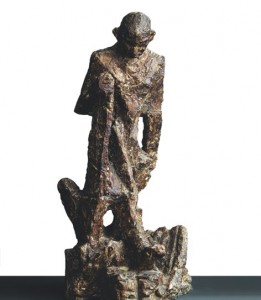
A-sculpture-by-Ramkinker-Baij
Intentional works of art enliven cultural and visual musings. My visual findings enrich communicative ability and transformative skill of abstract concepts of nature as the soul of figuration. The history of art presents genius of artists, known or unknown, whose work reveal human comprehension of their environment and life. I identify with figurative art, either representational or abstract as the expression of curious minds and inquisitive souls, revealing life’s beauty . Name three artists you would like to be compared with. To compare myself with artists or another era today may be presumptuous. However, I admire contemporary and painterly findings of poet Rabindranath Tagore, as well as the sculptural curiosity and visual ventures of sculptor and painter Ramkinker Baij. I respect the conceptual beauty and mindfulness of sculptor Krishna Chhatpar, my mentor at the Faculty of Fine Arts, Baroda.
If you had to revisit an art piece, which one would that be?
I think Lord Shiva Nataraja as a conceptual work of art is worth looking into. The diversity of my visual interest and taste for forms, materials, processes and work attract me to look at wide variety of works from the ancient world, old civilisations, and contemporary cultures.
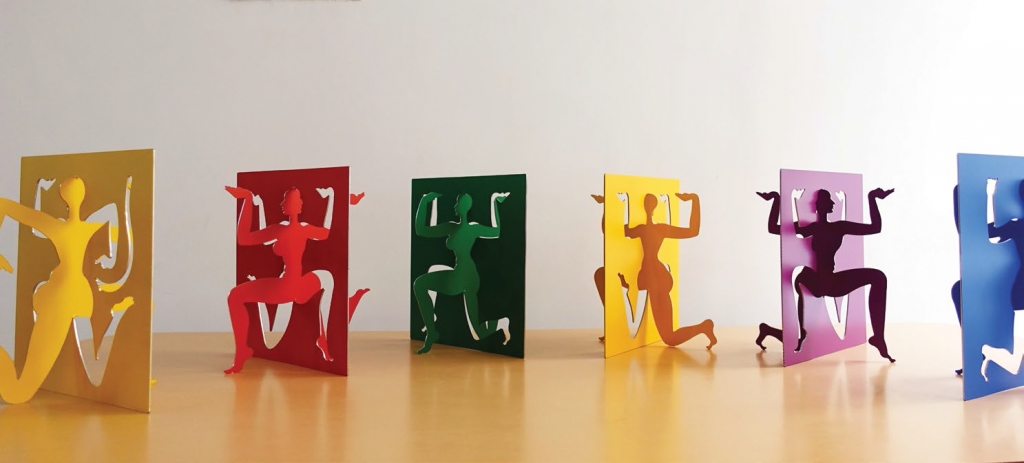
Which is your most recent artwork?
In 2015, I made a metaphorical set of work titled ‘Earth, Water, Fire, Air and Ether’ as emptiness or Sunyata in 8mm medium scale laser cut sheets. In Sanskrit, they relate to five aspects of god or absolute truth. Late that year, I made Spatial Diagrams of the six seasons or Vasant (Spring, mid February-mid March), Grishma (Summer, April-June), Varsha (Monsoon, June-August), Sharad (Autumn, August-October), Hemant (Pre-Winter, October-December) and Shishir (Winter, December- February) in 2mm stainless steel as an anthropomorphic experience.
___________________________________________________________
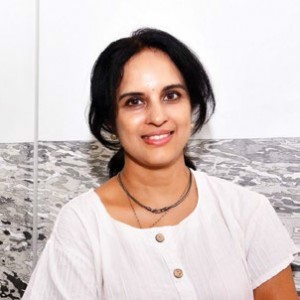
Parvathi Nayar
An artwork that invoked an influential experience?
If you allow me to pick two artworks by the same artist, I would pick Vincent Van Gogh’s ‘Café by Night’ and ‘Starry Night’. I saw images of them when I was really young, 13 I think, and remember having a moment of epiphany; of thinking, this person inhabits the world that I do, but he ‘sees’ it so differently. I felt that moment of wonderment at being able to see through another person’s mind and heart and head, a different view of the same world.
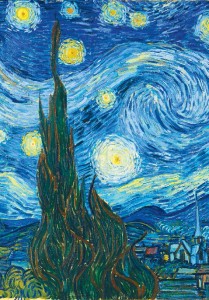
Starry-Night-by-Van-Gogh
What kind of art do you most identify with?
I identify most with contemporary art, for it is the art of our time that speaks about the times in which we live in.
Name three artists you would like to be compared with.
That’s a tough one. I have always admired artists across different disciplines who have had a specific vision of what they want to say – and have been able to say this through multiple styles/media – like filmmaker Peter Weir. His various films have different subject matters, but a particular ease of storytelling; or musician TM Krishna who articulates with such power. His belief in the music in changing times and landscapes; or writer Vikram Seth, who can equally harness prose and rhyme and images to tell his stories.
If you had to revisit an art piece, which one would that be?
Mick Jagger once said, “I haven’t had the time to plan returning to the scene because I haven’t left it.” I would rephrase that to say that while the works have moved and changed enormously, and art continues to be an ongoing process of play, experimenting and consolidating, I never want to revisit a particular artwork. However, I do like revisiting ideas and I see myself perhaps wanting to revisit the idea of gender some time from a fresh perspective.
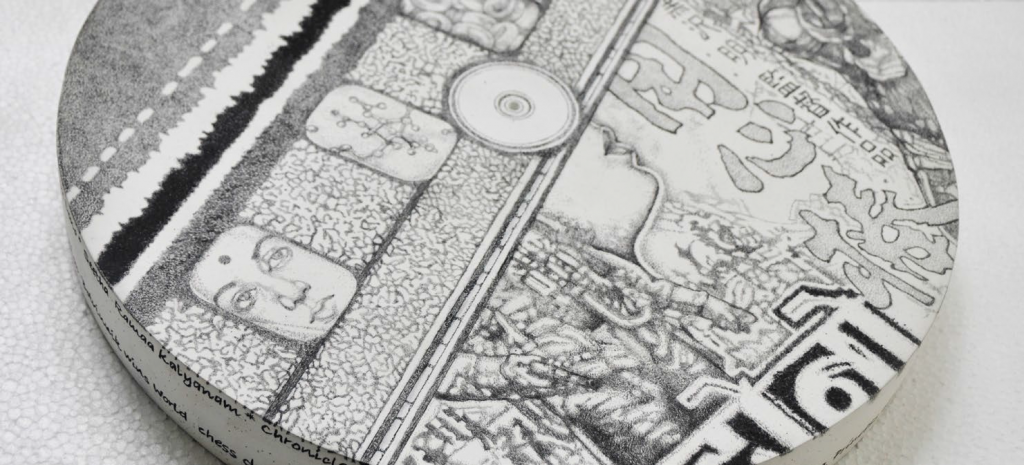
Which is your most recent artwork?
There are, at any given time, several on-going pieces that I work on, at different stages of completion. So it’s a continuum in that sense, the artist’s equivalent of a stream of consciousness that has freeze-frame moments when particular works unite. One of my recent works I completed is a series on carbon, both as carbon footfall and carbon as an organic source.
___________________________________________________________
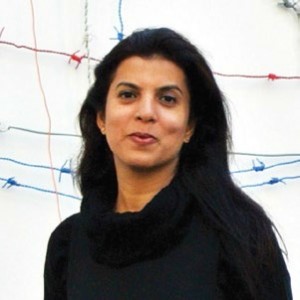
Reena Kallath
An artwork that invoked an influential experience?
A work by artists Jeanet Cardiff and George Bures Millerpresented at the Documenta 13 held in Kassel, Germany was a personal highlight in terms of the experience it provided, wherein viewers were given an iPod with headphones and asked to follow a prerecorded audio-video clipping. As one begins to navigate through different spaces that simultaneously play on the iPod, our experience in the present moment is constantly interjected and
overlapped with the past, shifting our perceptions between fiction and truth, myth and reality by the interweaving of some surreal moments.
What kind of art do you most identify with?
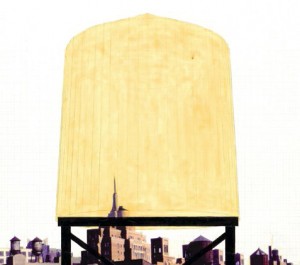
A Rachel Whiteread drawing at the Hammer Museum
While I most closely identify with art that has a strong conceptual core, I find artworks that can transcend beyond the idea, through the ingenuity of approach in their making (whether that might have to do with the process, language, form) usually engage the viewer more successfully, helping experience it both sensually and intellectually.
Name three artists you would like to be compared with.
I don’t like the idea of comparing one artist to another, since each one intrinsically has his or her own unique qualities. Certain works are more accomplished than others and there are certain artists who’ve redefined art giving it a new language. I would hope that my contribution to the field is valued for its nuanced approach and my work is remembered along with artists such as Rachel Whitread, Louise Bourgeoise, and Mona Hatoum, whose work I deeply respect.
If you had to revisit an art piece, which one would that be?
I’m looking forward to the forthcoming Lahore Biennale that will take place in November 2017 with artist Rashid Rana as the curator of the first edition. After the success of the Kochi Biennale and the Dhaka Art Summit in Bangladesh, that have established themselves as seminal platforms for art within South Asia, I think Pakistan can play a vital role by working closely in contributing to the collective richness that the region has to offer.
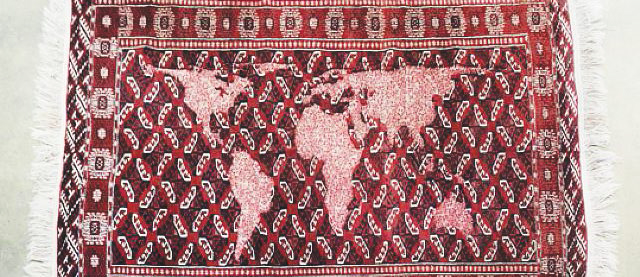
Which is your most recent artwork?
My last body of work titled ‘Hyphenated Lives’ is a reimagining of fantastical mutations within the natural world, where new hybridised species of birds and animals, trees, and flowers, otherwise fore-grounded as national symbols from countries politically-partitioned and proclaimed by nations as their own get combined, symbolically unifying the nations they represent. I felt the need to turn to a species other than the human race to tell us how to share the planet, where the existence of one species depends on the other, or the disappearance of one affects the other adversely.
___________________________________________________________
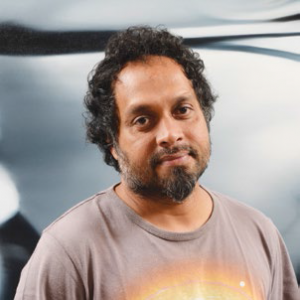
Riyas Komu
An artwork that invoked an influential experience?
It’s easy to beat the same drums again and go on about “classic artists” and how we all were inspired by the same familiar names. So, I shall use this space to pay homage to the new, specifically a film called Fandry – an exceptional, debut film written and directed by Nagraj Manjule and released in 2013. I think this is a film that can produce a seminal experience. Fandry is a multidimensional portrait of the caste system at work – in all its inhumane and brutal ways.
What kind of art do you most identify with?
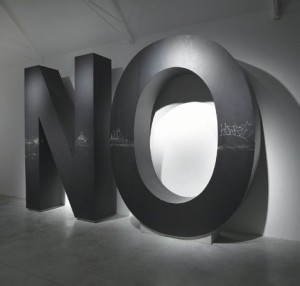
NO by Santiago Sierra
I am most influenced by music and cinema. When I say music, I am not talking about its therapeutic properties, but rather the ones which define a generation, or a culture or the medium itself. I grew up on the music of protest. I am not saying that’s the only thing that influenced me. But it’s amazing to think how a piece of music stays with you and help define a certain worldview or define a character or brings people together. The Malayalee is energised by Bob Marley’s music not just because of his politics but also because somewhere we feel a connect and see him as a “redeemer” through his music. The same is true with classical music in India. It’s not just music – it transcends the medium and creates a common connect for us all.
Name three artists you would like to be compared with.
This could be seen as pure vanity. In the context of art I’d like to think that there is something unique in every artist’s work. So comparison would be superficial. I love writers, storytellers, poets, musicians and everybody who creates art. I love the artists who take risks for their conviction and are politically and aesthetically powerful. So the artists I admire are complex and layered and takes you into many different directions and streams of thought. I am mostly an observer – to their process, art and life. To name a few, I like the practice of Santiago Sierra, the political interventions of Alfredo Jaar and the clarity of Amar Kanwar’s thought process. However, this is not a comparison.
Which is your most recent artwork?

My last work was titled “Get a Dark Cloud Free” and is part of my ongoing Experiments with Gandhi. It was exhibited at the Delhi Art Fair in February this year.
If you had to revisit an art destination, which one would that be?
One place I want to visit again is Barcelona. Not just because of the art, but because it is home to one of the world’s best football teams, and my personal favourite, Real Madrid; because it offers amazing architectural asterpieces; because of its outstanding culinary experiences and because it is packed with creative people.
___________________________________________________________
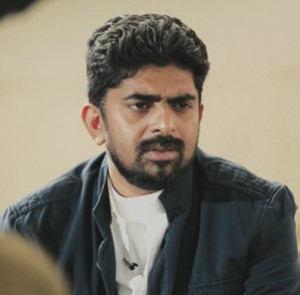
Sumedh-Rajendran
An artwork that invoked an influential experience?
Artworks from the baroque period. It is hard to point out a single work among those treasures. Albert Camu’s “Happy Death” in literature and Andre Tarkovsky’s film “Ivans Childhood” have really invoked great experiences in me.
What kind of art do you most identify with?
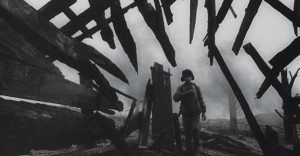
A still from Ivan’s Childhood
As a sculptor dealing with time and its constant negotiation with the surroundings, I try to understand and identify myself with films and architecture. Both articulate time and space in its own way and brings new meanings and experiences to everyone.
Name three artists you would like to be compared with.
The practice of art to my perception is a process of realisation that cannot be compared or gauged. Each artist tries to bring their own experience and interpretations. And for this same reason, I would not want to be compared with any other artist.
An artwork that has surprised you?
An early eighth-century bronze sculpture of Shiva and Parvathi from the Thanjavur museum. Its enigmatic revelation about the art practice is prodigious.
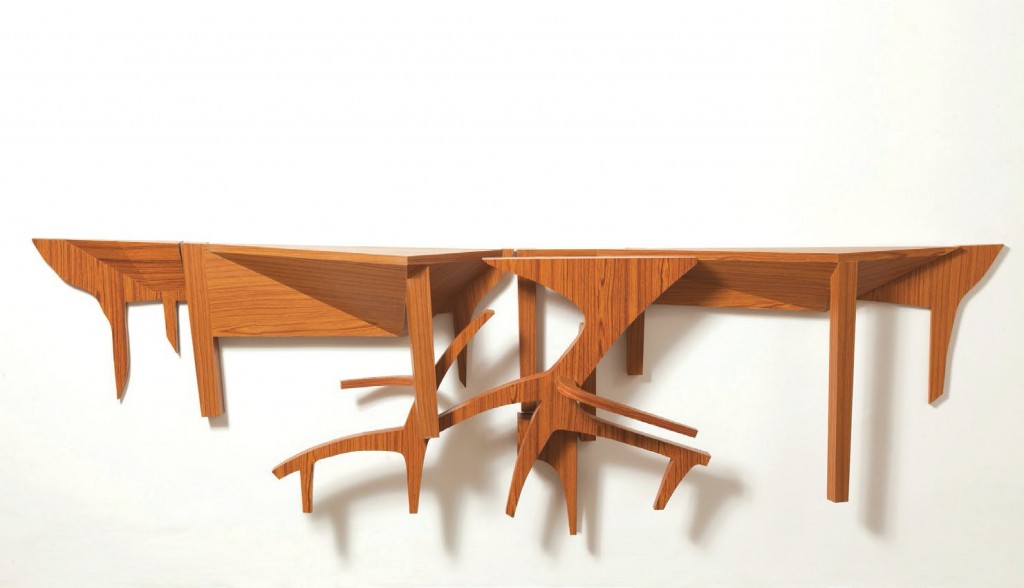
Which is your most recent artwork?
My latest work is “Half Real” which is about things that lose its real meaning of existence and transform into another; those that end up carrying a fabricated memory.
Words by FWD Media Photographs from Various Sources
The post DOWN THE ART LANE WITH 5 ARTISTS appeared first on FWD Life | The Premium Lifestyle Magazine |.
]]>The post Sumakshi Singh and Art of Illusion appeared first on FWD Life | The Premium Lifestyle Magazine |.
]]>“I don’t define art. If you define it you kill it. If I had to say it then I wouldn’t be making it.”
A vantage point is not just a physical entity. Sumakshi Singh’s explorations into perspective have made her an internationally recognized contemporary artist. Born and brought up in Delhi, Sumakshi was trained in painting at M S University, Baroda. Since then she has travelled all over the world working and exhibiting.
She creates site specific installations which prod the existence of time, understanding, fist interpretations and self-reflection. Drawing from her own experiences, the artist uses mix media to draw you into the artwork and leave you with transcending thoughts.
What does the Biennale mean to you?
What you see here is a lot of goodwill coming together. Often in the art world and at art fairs what you sense is a kind of competiveness and galleries favoring their artists. Here art is not for sale and is not a commodity.
Artists and curators are all stepping in to offer their own private funds and energy. A community is coming together to make this happen which is a really positive thing for the art fraternity. What I’m enjoying about the Biennale is that it is all about ideas and pushing your practice, along with pushing the context of everybody’s practice.
What has been your experience so far?
It is very inspiring to be here. A large part of it is due to the fact that the curator Jitish Kallat has individually worked with the artists on their concepts and ideas. He has asked us to work on our ideas and not take short cuts. We are inspired to go all out. You don’t really see that in many places in the art world. This is not market driven and it is really about ideas and having a dialogue. This is an incredible platform for people to come and really expand their practice and tap into inspiration.
How do people interpret your work?
I make art for self-discovery. I ask the artwork what it wants to become and then onwards it’s a strange little dance. I feel uncomfortable when I work. I am a person who wants to be in control. I don’t know what it is going to become, but learning to trust is very soothing. Very often people understand exactly what I am hoping for and beyond. When somebody comes back and tells me what they saw, suddenly there is a bubble of joy inside due to a realization that what they saw is what I unconsciously meant it to be. Obviously, something is coming through the work that is not from your brain or your conscious intent, but it is like ‘you’ are just seeping through your work.
For some people, my art is very much like a mark of our generation where we are in multiple places at the same time. Where are you really? How do you locate yourself? Our generation deals with this all the time with Skype, Facebook and SMS. Is it where your physical body is placed, where your attention is or a meeting online? There is this multiplicity now and space is collapsing in a way. If two hundred years ago. You tell someone that you could talk to another without being in the same room, they would not believe you. Other thing that people tell me is that it is like a space -time hiccup.
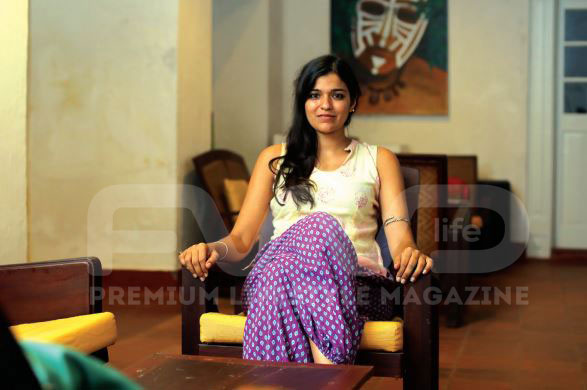
Your vision gets stuck at one point in space and somehow you are allowed to walk away from it and enter it from another angle. In a way, you are in an abstract map of your own vision. My yogi and monk friends often see my work from the angle of ‘Maya.’ It is an illusory world that we inhabit and it is only through the mediated do we try to make sense of our world. What is real and how do you recognize it? There are many questions that I have in my mind and that comes out through the work.
Tell us about your current work
I am doing an installation at Pepper House where I work now from nine in the morning to nine at night. You enter this seventy foot long room with scrolls of paper hanging floor to ceiling at twelve feet height. You see a swirling group of planets, an astronomy diagram that are actually based on the ‘Suryasiddhanta,’ an ancient text. It talked about gravity and calculus way before Newton. A lot of the drawings and mythologies are projected on large sheets of paper. Then you come across a table where there is an open manuscript where birds are fling, a tree is growing and people are moving.
It is a conglomeration of the history of Kerala. Afterwards, you enter a maze of hanging scrolls and as you walk around you see semi abstract drawings. You walk further and you see yourself as a live projection where you are now in the book. You have become a character in the manuscript and the latest addition to Kerala’s history.
The post Sumakshi Singh and Art of Illusion appeared first on FWD Life | The Premium Lifestyle Magazine |.
]]>The post KCA’s Jayesh George Speaking appeared first on FWD Life | The Premium Lifestyle Magazine |.
]]>The KCA was formed in 1951 and has been working hard to attract more talent in Kerala. With the assistance of the BCCI (Board of Control for Cricket in India) the KCA has built stadiums in Krishnagiri and Perunthalmanna with new stadiums in each of the 14 districts already in planning stage. The organization’s CASH (Cricket Academies and Sports Hostel) project is a model to other states, and they have funded over 400 girls and boys in the last year alone. The association is implementing Mission 2020 which will see cricket reach new levels in the state. They have also leased out the stadium from the GCDA (Greater Cochin Development Authority) for thirty years. Committed to the development of sports, Mr. Jayesh is ecstatic about the various leagues that are coming up in the country.
At the moment, his hands are filed with the proceedings of the impending matches. Mr. Jayesh oversees over various committees; ground, wicket, food, security, etc. It takes about three to four months to organize an international level game at the stadium. The stadium and wicket committee starts the work from day 1. The grass used at the stadium is Bermuda grass that needs to be mowed every week. Weeding and watering happen daily as it needs constant care. The ground needs six covers if it rains the night before the game and 100 people are required for the process. Mr.Jayesh remembers a time in 2010 when the game got washed out. The outfield is mowed at 12mm and the wicket at 6mm for cricket. For football, the out-field is mowed at 24mm and the wicket at 4mm. Imagine the attention to detail.
Upto 500 people are involved in the production of a game. Mr.Jayesh is thankful for the constant support from the police and fire force apart from their team. There are thirty-two gates that are monitored by CCTV cameras from the venue operation centre.
There is also a special room for the press, anti-corruption committee, first aid, recreation, players’ area, etc. There are twelve first aid stands for the public and 120 medical staff just for the players. Provisions for the food vendors are made. Over 60,000 people come to watch the matches, and the ticketing is done by NCC cadets. Few people realize the amount of work that goes behind the game. Two to three days before the big day, mock drills are carried out. Currently, the dressing rooms are undergoing a makeover for the ISL. For the West Indies match, their dressing room was decked out in red. Though India lost that game, Mr. Jayesh is happy that the team could pull a hassle free game with a good wicket.
Passion for Sports
Jayesh George started playing cricket from a very young age. He used to play for the Kochi team, Swantons, at the Durbar Hall grounds. Tinu Yohannan and Feroze Rasheed, ex Kerala players, rose through the same team. Mr. Jayesh remembers how the team was like his family, and they used to hang out at the coach N S Krishnan’s Chittoor home. His love for the game led him to be the secretary for the Ernakulam District Association between 2005 and 2013. He was selected as KCA joint secretary in 2013 and joined fellow cricketer T C Mathew, who is the current President. Mr.Jayesh currently plays for the Kochi Strikers in the Veteran’s Premier League, Kerala. The former Swantons player has great expectations for sports in the country. There are lots of changes that still need to be made. Most people don’t take sports as a career due to an issue with job security. In Kerala, only State Bank of Travancore offers employment. Sanju Samson is a great inspiration for young sports persons, and Mr.Jayesh believes he has a long way to go. He jokes that though he is a cricketer his children are avid football fans. We see our team playing at an international level for cricket; this is not the case with football. Hopefully with the ISL, this scenario will change. Sports in India need a lot of encouragement and support, and Jayesh George is doing his bit.
The post KCA’s Jayesh George Speaking appeared first on FWD Life | The Premium Lifestyle Magazine |.
]]>The post ‘I am a thani malayali penkutti’ appeared first on FWD Life | The Premium Lifestyle Magazine |.
]]>
Photos: Suneesh Suresh
“It was my dream to come to India. I wanted to understand the culture, live it and dive into it.”
Miriam Rahul Raj sounded extremely Indian over the phone. Not that she shouldn’t, but then when you are told to meet composer Rahul Raj’s German wife, you tend to make some assumptions. Miriam walks out in a flowing skirt, a stitched blouse with her forehead marked in a bindi and earrings dangling from her ears. I watch as Miriam haggles with the fish lady in perfect Malayalam to buy fresh ‘karimeen’. Rahul remarks that she makes a mean ‘meen’ curry.
We sit down in Rahul’s studio where he has composed music for Ritu, Chota Mumbai, Time etc. This is Miriam’s first interview, and her two-year-old daughter Akshainie stands close to her in a pretty pink. Her open mindedness and an attitude to take things as they come have made her ease into the nuances of daily life here since she came in 2005. Rahul and Miriam live with Rahul’s parents who consider her their own daughter. When Rahul teases her about not being a fan of his music, Miriam replies in typical Malayali fashion “Onnu illa. Onnu po.” Ready with a smile and an encouraging remark for Akshainie every few minutes, Miriam tells us about life in Kerala.
What was your childhood like?
My parents are devotees of Matha Amrithanandamayi and at the same time they used to visit the church. My father instilled a lot of Indian values in me. I grew up being fascinated by India and its culture. I used to wear a bindi and a saree to school though I didn’t know how to drape one. People have called me an Indian freak; maybe I was an Indian in my past life. My parents never tried to force their beliefs on me, and I was given the option to choose my religion.
What drew you to India?
Maybe it is because the climate in Germany is so cold, I felt people were very uptight. While growing up, I was fed up with everyone and their materialistic attitudes. There would be complaints if a bus was a minute late or something was not perfect. Here we take things more or less in stride. Most importantly, here I can explore my spirituality. Now I have come to realize that both cultures have its positives and negatives. I am able to balance both in myself and be at peace.
How did you meet Rahul?
I was part of Amma’s ashram in Kollam. I approached Amma one day and told her that I wanted to get married. I wanted her to choose my partner. Rahul and I had common friends, and we were introduced. The rest is history like they say and with Amma’s blessing we got married.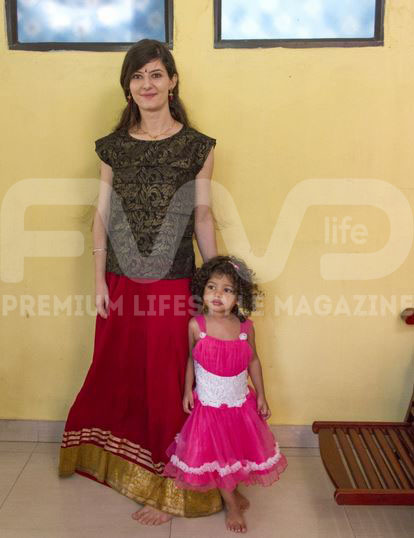 What were some of the things that surprised you?
What were some of the things that surprised you?
I stayed in a hostel while pursuing Computer Science in Kollam. I could not understand the rules and regulations. You had to sign in and sign out at a particular time. You could not talk to boys. In Germany, I had a lot of freedom and independence though my father did not allow me to go to parties. By the time, you are eighteen you are expected to make your own decisions. Then I moved into the Ashram were there was a lot of discipline and structure to my day
By then I thought I had everything figured out. As a student, you are still like a tourist in Kerala. I didn’t know how it was like to live in a family. My in laws have been extremely gracious. Initially, I couldn’t figure out what people expected from me which is something I don’t have to worry about back in Germany. Hospitality is different too. Here you have to ask each guest what they would like to have and when sitting down for a meal, you are spoiled by people who keep serving you even though you say you have had enough.
What would you change here?
Everything is a bit too unstructured in our cities. We say that the city is developing, and all you see is a mess. Maybe it’s the German in me, but I have an eye for detail. We talk about international standard buildings, etc. and I see cracks and unfinished surfaces. Also, I wish people approached medicine a bit more responsibly. I find doctors are followed blindly, and you take medicines when you don’t need them.
How much of a Malayali are you?
(Miriam laughs). I have always been known to be late, I guess that counts. On a serious note, I think I know too much about the culture to feel like an outsider anymore. I love ‘pulisserry’ and ‘thoran’. Rahul says I’m a ‘thani Malayali penkutti’. (Rahul remarks that she is quite the whiz in the kitchen and makes the best dosas he has had).
What about Akshainie?
Children have such an amazing capacity to absorb languages at this age. I am teaching her German. So now she will have a mother tongue, father tongue and a family tongue. (Miriam laughs). We visit Germany once a year though my father would like to make that thrice a year. My parents and brothers also come to Kerala often. I want Akshainie to have the best of both worlds.
The post ‘I am a thani malayali penkutti’ appeared first on FWD Life | The Premium Lifestyle Magazine |.
]]>

